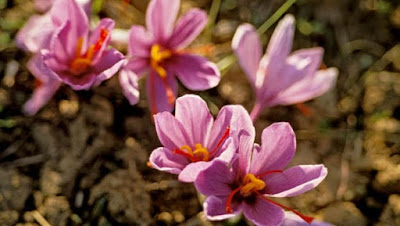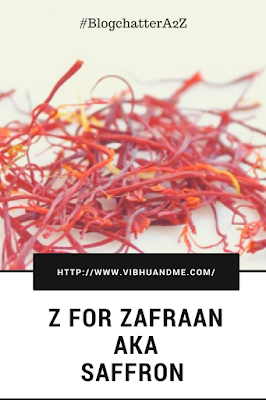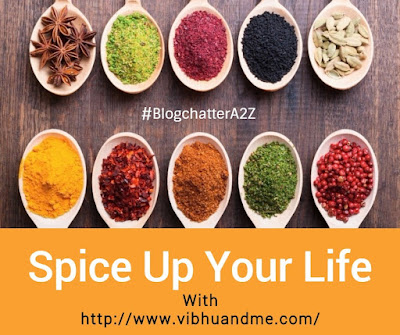Once happened when my parents decided to make Chywanprash at home. Yes, it can be made even at home. The recipe was given by my father's maternal grandfather. He was a famous Vaidya of his time. There were close to 50 ingredients needed for Chywanprash and when my father brought them from the market, I was mouth opened. I had never seen any preparation with 50 ingredients. Opening each of the packets, I asked my mother about it. Those were mostly spices and dry fruits. Then there was a cute small box that pulled my attention. I took it in my hands and saw the price tag. 1000 rupees!! I was stunned and astonished. How come such small quantity cost this much? My mother explained that it was the costliest and the most precious spice, Kesar. For the first time, I heard about something which looks like threads but is pricey like anything.
For us, it could look simple that making saffron requires plucking the delicate mauve blossoms, it is very hard work in reality. Taking some 75,000 flowers yields just one pound (454 grams) of dried saffron. Each flower has three maroon stigmas growing from one pistil, and three worthless golden stamens. It is just the stigmas that are the precious spice and sadly the exquisite petals and the stamens have no value at all. Stigmas are handpicked and then carefully laid on a sieve and cured overheat to deepen the flavors. In Pampore (Kashmir) the only crop is Zafraan. The first reason is favorable soil and weather conditions, and the second, availability of inexpensive labor. Thus it is the norm in Pampore that every member of the family pitches in during the plucking season of Zafraan flowers for at least six hours a day, starting from dawn. Because it is such painstaking work to obtain one kilo of saffron, it is costly and often gives a reason for making a similar fake substance.
Z For Zafaran
Kesar is called Saffron in English. However, I have decided to mention it with name Zafraan as the Persian word zarparān, which means 'having golden stigmas' has derived the name of this adored spice. The English word 'saffron' does come from the Latin 'safranum', which is an inspiration from the frennch word 'safran'. I feel Zafraan is the perfect spice to write about in my final post of #BlogchatterA2Z.
Zafraan (saffron) is both a spice and a color. If you eat raw strands, it tastes bitter. However, when added in milk and sweets, it gives a lingering flavor to them. Zafraan remained as a magical substance for people for years as this spice is not self-reproducing. It needs human intervention to be grown. Zafraan is such a blessing that it makes the dish automatically expensive in which it goes. And its extra demand makes sure to keep the spice costly always. It may be expensive but you need only a little quantity to feel it. One or two strands, steeped in liquid, can infuse a whole pot of rice with its dry, floral aroma. Too much of a good thing is bitter and unpleasant, you know.
Unlike other spices that require either frying in heated fat (oil/ghee) or grinding to release their flavors and aromas, Zafraan does not need anything but water. Steeping saffron strands in cold water overnight results in a beautiful clear gold liquid with a faintly bitter taste that fades at near-sweetness and fine fresh aroma. A lot of scientific research has been done to understand the nature of Zafraan. And it is found that there are certain unique flavoring molecules present in Zafaran that make it taste differently. A different taste when dissolved in water and a reacher taste when boiled in milk.
Zafraan (saffron) is both a spice and a color. If you eat raw strands, it tastes bitter. However, when added in milk and sweets, it gives a lingering flavor to them. Zafraan remained as a magical substance for people for years as this spice is not self-reproducing. It needs human intervention to be grown. Zafraan is such a blessing that it makes the dish automatically expensive in which it goes. And its extra demand makes sure to keep the spice costly always. It may be expensive but you need only a little quantity to feel it. One or two strands, steeped in liquid, can infuse a whole pot of rice with its dry, floral aroma. Too much of a good thing is bitter and unpleasant, you know.
Unlike other spices that require either frying in heated fat (oil/ghee) or grinding to release their flavors and aromas, Zafraan does not need anything but water. Steeping saffron strands in cold water overnight results in a beautiful clear gold liquid with a faintly bitter taste that fades at near-sweetness and fine fresh aroma. A lot of scientific research has been done to understand the nature of Zafraan. And it is found that there are certain unique flavoring molecules present in Zafaran that make it taste differently. A different taste when dissolved in water and a reacher taste when boiled in milk.
Many spices come from plants that grow in the tropical zone, where most of India falls, and probably it is why India cultivates almost every spice. But the Zafraan grows best in the subtropical zones that surround the tropics and in mild weather conditions with a fairly cool climate. That is why Kashmir is the only place in Indian where Zafraan grows. In present day scenario, the largest producer of Zafraan crop in the world is Iran, though about one-tenth of this crop is originated in Kashmir and the rest comes from Greece, Italy, and Afghanistan in distinct proportions.
But why Zafraan, aka saffron, is so precious?
 |
| Saffron Flowers (Credit: Google Image search) |
History of Zafaran
Zafraan's exact point of origin is not clear, but it was probably in the Eastern Mediterranean. The earliest evidence that the East Mediterranean people were growing Zafraan, as early as 2300 B.C.,was the mention of a great king, Sargon of Akkad, a great ruler of the Akkadian empire having hailed from the city of Azupiranu, referred as Saffron City in ancient history texts. Interestingly, frescoes dating back in 1600 BC found in Knossos, Greece portrayed the whole process of Zafaran harvesting. In the millennium that followed, Zafraan made its way East across Asia, maybe reaching Kashmir between 700-500 BC.
Zafaran was a luxury saved for kings and queens those days. They wore saffron perfumes, saffron-dyed robes, ate food and had drinks with saffron spice, bathed in saffron water for healing, slept in beds speckled with saffron threads, and prayed to their gods with saffron offerings. To the great Buddhists it is believed by a tradition from Kashmir that saffron was introduced to the monk Madhyantika. In his ruling, many medicinal herbs have been imported and planted in India wherever they were not previously available. Zafraan was also popular that time. It was so quickly absorbed by the Indians that they downgraded their native turmeric which was also a religious spice. That place was slowly taken by costly Zafraan. Indian Astrology says that the Zafraan (Kesar) tilak brings good luck and long life. And since ages, Indian ladies have been using Kesar to enhance their beauty.
Ayurvedic Benefits of Zafaran
All ancient mentions clearly state that back in the past, Zafraan was most sought after spice for its magical powers to heal a whole line of ailments. And Zafraan is used predominantly in Ayurvedic medicine too. It is often referred as Kumkum in Ayurvedic texts. It was recommended to heal simple discomforts to serious disorders in all age groups. Zafraan contains more than 150 volatile compounds that are good for the overall well-being of the body. Diseases like asthma, cough & cold, stomach disorders, insomnia, uterine bleeding, cancer, Alzheimer, infertility, depression, cholesterol issues, flatulence, for all of these, Zafraan is prescribed. The other benefits of Zafraan are:
- Anti-oxidants
- Antidepressant
- Analgesic
- Immunity booster
- Promotes learning and memory retention
- Delays puberty
- Increases vitality:
- Cures patchy baldness
- Protection against cold
- Great for skin and hair
- Good for digestion
- Keep in check blood pressure and heart rate
Dadi Maa Ka Nuskha
Have Zafraan milk and apply Zafraan mixed in milk over the forehead to quickly get relief from cold.
How to buy
Because Zafraan is expensive, it is often sold as something which has a close resemblance to it. So you need to careful in buying the Zafraan box. It is common to mix fake and real saffron together. It is also not unheard of to keep saffron strands moister than they should be, because water makes them heavy. Buy a known and established brand only. Some shops also provides quality checks for saffron.
Have Zafraan milk and apply Zafraan mixed in milk over the forehead to quickly get relief from cold.
How to buy
Because Zafraan is expensive, it is often sold as something which has a close resemblance to it. So you need to careful in buying the Zafraan box. It is common to mix fake and real saffron together. It is also not unheard of to keep saffron strands moister than they should be, because water makes them heavy. Buy a known and established brand only. Some shops also provides quality checks for saffron.
(I am taking part in #BlogchatterA2Z and today’s letter is 'Z'.)
You can read my other #BlogchatterA2Z posts here :
You can read my other #BlogchatterA2Z posts here :
- A For Alkanet Root - A Magical Spice
- B For Black Salt - A Digestive Stimulant
- C For Cinnamon - God of Spices
- D for Dried Ginger - A More Beneficial Form of Ginger
- E For Edible Silver and Gold Foils
- F For Fennel Seeds - More Than A Mouth Freshener
- G for Green Cardamom - The Queen of Spices
- H For Holy Basil - The King of Herb
- I For Indian Gooseberry - A Super food
- J For Jaggery - A Medicinal Sugar
- K For Kalpasi - An Unknown Treasure
- L For Long Pepper - An Underrated Spice
- M For Mace - The Cousin of Nutmeg
- N For Nutmeg - The Pricey Spice
- O For Onion Seeds - The Flavor Master
- P For Poppy Seeds - The Nutty Savor
- Q For Quinoa And Quatre-Epices
- R For Red Chili - The Fierce Spice
- S For Star Anise - The Beautiful Spice
- T For Turmeric - The Golden Spice
- U For Urad Dal - A Great Tempering Ingredient
- V For Vinegar - The Sour Agent
- W For White Sesame Seeds - A Nutrient Rich Eat
- X For Xacuti Spice Mix - A Goan Specialty
- Y For Yellow Mustard Seeds - More Than A Sauce Ingredient












I still remember the grannies telling the pregnant women to eat zafraan to ensure that the child will be fair. Sigh! Another very informative post, Shipra. Waiting for the ebook now. Congrats on a successful AtoZ
ReplyDeleteThank you Varad. Wish your ebook a great success too.
DeleteThis was quite informative .. i knew just a few things about previous Saffron.. sharing and saving this post :)
ReplyDelete